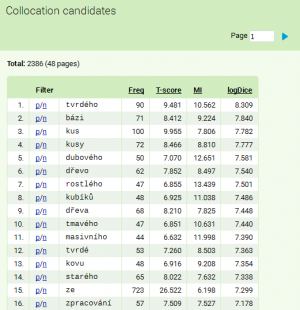Menu: Collocation
One of the principal properties of interface KonText is the possibility to use statistical methods to identify collocations of a wanted word. By collocation, we understand a meaningful, fixed, syntagmatic sequence of two (or more) words in the immediate proximity. A collocation consists of a key word (node which usually is also KWIC) and a contextual word (collocate). The list of collocation candidates with which a wanted word or a phrase collocates forms the basis for corpus analysis, as it enables us to determine what kind of context is typical for a wanted phenomenon.
Association measures are used to identify a collocation. Interface KonText presently employs the following basic ones: t-score, MI, MI3, log likelihood, min. sensitivity, logDice, MI.log_f, relative frequency. Each of the measures is sensitive to different kinds of phrases and each might not work in some cases. It is therefore recommended to combine the measures and compare their output. The statistical analysis by association measures generates a list of collocation candidates and it is up to the researcher to decide whether they really are legitimate collocations.
Suppose that we created a concordance of lemma dřevo in the corpus SYN2010. By clicking on the Collocation item in menu, a form for collocation analysis will appear. In the form it is possible to specify the following values when searching the collocations within the scope of created concordance:
- Attribute: the selection of positional attribute of a collocate (we can search for the surrounding lemmas of the lemma dřevo, the words or any other available attributes)
- In the range from - to: specification of the contextual span (in the proximity of KWIC) where the collocates will be searched for (negative numbers indicate the positions preceding KWIC, while the positive ones follow KWIC, cf. frequency distribution))
- Minimum frequency in corpus: establishes minimum overall frequency of a unit in order to be included in the collocate list (provided that the minimum frequency is set on 5, the collocate of lemma dřevo cannot be those items that occur in the whole corpus less than 5 times)
- Minimum frequency in given range: provided that we specified the context span for collocate search from -3 to 3, then the minimum frequency in given range option determines how frequently should an item co-occur with KWIC to be included in the collocate list (when calculating the association measures only those items will be taken into consideration which occur at least 3 times in the proximity of KWIC, lemma dřevo in our example)
- Show functions: which association measures will be calculated and listed for each of the collocates that the conditions specified above are met
- Sort by: according to which of the association measures will the list be sorted (especially useful for the long lists)
Collocation list
Based on the submitted specifications, lemma dřevo co-occurs with 2386 different words (attribute word) which can function as its collocates. Sorting by logDice produces a list with the following forms as the most significant collocate candidates: tvrdého, bázi, kus, kusy, dubového…
The list comprises of both the overall frequency of co-occurrence of the wanted phenomenon and its collocate (e.g. of lemma dřevo and collocate tvrdého) and the values of selected association measures for that collocation. By clicking on the column header, the list will be rearranged according to the selected value. Just like in the list of frequency distribution, it is possible to create positive or negative filter with the link p/n in the collocate list which searches for the collocate in the proximity of the initial KWIC.
Two precautions must be mentioned here:
- The collocate list includes all of the words which correspond to the specifications of the context span, minimum frequency in the corpus and range, regardless of whether they really are collocates or not. Association measures can be used only to rearrange all of the items that meet the given criteria - whether the given word really functions in the collocation with the wanted phenomenon (whether it forms e.g. syntagma with it) forms the basis for further research which cannot be judged based only on the value of association measure (which functions rather as an aid for filtering out tedious and statistically insignificant collocates to the end of the list)
- Each of the association measures is sensitive to different kinds of collocation. It is therefore necessary to go through the collocation list more than once, using different kinds of association measures to rearrange it.
Menu: Query • Corpora • Save • concordance • Filter • Frequency • Collocation • View • Help

